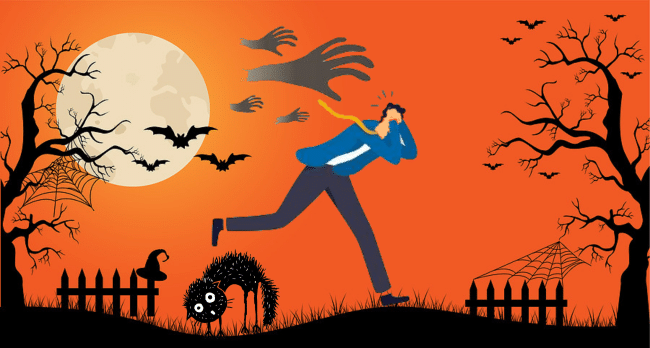
Ghosts and goblins may not need disability insurance, but the millions of U.S. workers who depend on a paycheck do. This October, many people will be watching horror movies and wearing scary costumes, but nothing is more frightening than facts about disability and what can happen without disability insurance.
 The Real Danger that Lurks in the Shadows
The Real Danger that Lurks in the Shadows
The National Institute of Mental Health says that around 12.5% of U.S. adults experience a specific phobia at some point in their lives. According to YouGov America, 30% of U.S. adults are afraid of snakes, 28% are afraid of heights and 24% are afraid of spiders. Disease and germs also made the list of fears, but so did clowns and feet.
People are afraid of a lot of things, and our fears aren’t always rational.
This Halloween, many people will watch scary movies about zombies, vampires and werewolves. That’s all in good fun, but when it comes to making plans for the future, sometimes we need a heavy dose of reality. These statistics show why the financial impact of disability is scarier than any movie monster:
- You’re more likely to experience a disability than a zombie attack. The Social Security Administration says that 25% of 20-year-olds experience disability before reaching retirement age. Currently, a person has an approximately 0% chance of being eaten by a zombie.
- You have a greater chance of becoming disabled than you do of becoming a vampire. The CDC says more than 70 million adults in the U.S. have at least one disability. There have been exactly 0 verifiable accounts of U.S. adults being turned into an actual vampire.
- You’re more likely to get saddled with medical debt than a werewolf curse. KFF says that around 14 million U.S. adults have at least $1,000 in medical debt. As far as we’re aware, no U.S. adults are now or ever have been cursed to turn into a werewolf on the night of a full moon.
 A Disability Can Suck Your Savings Dry
A Disability Can Suck Your Savings Dry
Many Americans are living paycheck-to-paycheck, but some Americans have managed to build up a decent savings. According to a 2025 Bankrate survey, only 27% of Americans have enough emergency savings to cover six months of expenses, while 19% have enough to cover three to five months, 30% have some savings but not enough to cover three months, and 24% have no emergency savings at all.
Six months of savings sounds like a nice cushion. If someone experienced an unexpected layoff, this amount of savings would give them some breathing room while they look for a new job. This amount could also give people the flexibility to take some time off work to deal with a family emergency even if they didn’t have paid leave. But what happens when the six months are up and you still can’t work?
Some people might have more than average savings, or they might be able to tighten their belts and reduce their spending, but with housing and food costs on the rise, this may be easier said than done. Someone who’s unable to work because of an illness or injury might also have out-of-pocket medical bills on top of all the regular living expenses.
The truth is that a disability can suck your savings dry. Even if you have a decent amount of savings, and even if you’re trying to be frugal, if you’re not replacing some of your lost income, you’re going to run out at some point. This reality can be more frightening than any Halloween movie.
 Disability Insurance Is Better Than a Nightlight
Disability Insurance Is Better Than a Nightlight
If you’re afraid of the dark, you might invest in some nightlights. If you’re worried about the financial impact of disability, you can invest in disability insurance.
Disability insurance replaces a portion of your income if you can’t work because of a disability, such as an illness or an injury. Some people get limited disability insurance coverage through their work, but it’s also possible to buy individual disability insurance to secure more robust, portable and customizable coverage that replaces a higher percent of the worker’s normal salary. This is important coverage for anyone who depends on a paycheck, even if they have some savings, and insurance sales agents should tell their clients about it.
 Show Your Clients What’s Really Scary
Show Your Clients What’s Really Scary
Many people don’t like to think about death, disability and other dark topics. However, this Halloween, when plastic skeletons and tombstones decorate our neighborhoods, it’s a good time to broach the subject.
This Halloween, show your clients what’s really scare – facing disability without disability insurance. Drive the point home with the Implications of Income Loss infographic.
